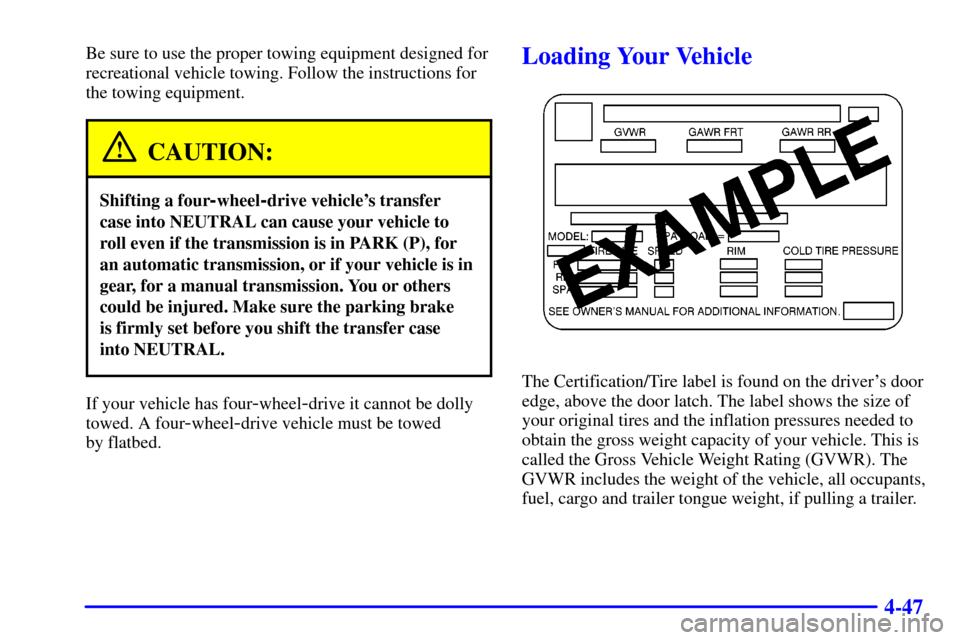Page 118 of 488
2-52
Cruise Control (If Equipped)
With cruise control, you can
maintain a speed of about
25 mph (40 km/h) or more
without keeping your foot
on the accelerator. This can
really help on long trips.
Cruise control does not
work at speeds below about
25 mph (40 km/h).
If you have an automatic transmission and you apply
your brakes, the cruise control will shut off.
If you have a manual transmission and you apply your
brakes or push the clutch pedal, the cruise control will
shut off.CAUTION:
�Cruise control can be dangerous where you
can't drive safely at a steady speed. So,
don't use your cruise control on winding
roads or in heavy traffic.
�Cruise control can be dangerous on
slippery roads. On such roads, fast changes
in tire traction can cause needless wheel
spinning, and you could lose control. Don't
use cruise control on slippery roads.
Page 123 of 488

2-57
Daytime Running Lamps
Daytime Running Lamps (DRL) can make it easier for
others to see the front of your vehicle during the day.
DRL can be helpful in many different driving
conditions, but they can be especially helpful in the
short periods after dawn and before sunset. Fully
functional daytime running lamps are required on all
vehicles first sold in Canada.
The DRL system will make your headlamps come
on at reduced brightness when the following conditions
are met:
�The ignition is on,
�the exterior lamp control is in OFF,
�the sensor detects daytime light,
�an automatic transmission is not in PARK (P), and
�the parking brake is released.
When the DRL are on, only your headlamps will be on.
The taillamps, sidemarker and other lamps won't be on.
The instrument panel won't be lit up either.
When it begins to get dark, the headlamps will
automatically switch from DRL to the regular
headlamps.The DRL system on some vehicles may turn off
temporarily while the turn signals are activated.
To idle an automatic transmission vehicle with the DRL
off, put the transmission in PARK (P). To idle a manual
transmission vehicle with the DRL off, set the parking
brake. The DRL will stay off until you shift out of
PARK (P) or release the parking brake.
The following does not apply to vehicles sold in Canada.
When necessary, you may turn off the automatic
headlamp system and the Daytime Running Lamps
(DRL) feature by following the steps below:
1. Turn the ignition to RUN.
2. Press the DOME OVERRIDE button four times
within six seconds. After the fourth press of the
button, a chime will sound informing you that the
system is off. The system will revert back to the
automatic on mode when the ignition is turned to
OFF and then to RUN again.
3. To return to the automatic mode, push the DOME
OVERRIDE button four times within six seconds
(a chime will sound), or turn the ignition to OFF and
then to RUN again.
As with any vehicle, you should turn on the regular
headlamp system when you need it.
Page 150 of 488
2-84
Instrument Panel Cluster
Your instrument panel cluster is designed to let you know at a glance how your vehicle is running. You'll know how
fast you're going, about how much fuel you've used, and many other things you'll need to know to drive safely and
economically.
Base Level cluster with Automatic Transmission United States, Canada cluster similar
Page 151 of 488
2-85
Uplevel cluster with Automatic Transmission United States, Canada cluster similar
Page 290 of 488

4-45
In rare cases when it's unavoidable and your vehicle
must be towed with all four wheels on the ground, the
propeller shaft to axle yoke orientation should be
marked and the propeller shaft removed following the
applicable service manual removal/installation
procedure. See ªService and Owner Publicationsº in
the Index.
Dust or dirt can enter the back of the transmission
through the opening created by removing the propeller
shaft if proper protection is not provided. Also, check
the transmission fluid level before driving the vehicle.
When towing your vehicle, turn the ignition to OFF.
To prevent your battery from draining while towing,
remove the RDO BATT and CLSTR fuses from the
instrument panel fuse block. Be sure to replace the fuse
when you reach your destination. See ªFuses and Circuit
Breakersº in the Index.Be sure to use the proper towing equipment designed for
recreational vehicle towing. Follow the instructions for
the towing equipment.
CAUTION:
Shifting a four-wheel-drive vehicle's transfer
case into NEUTRAL can cause your vehicle to
roll even if the transmission is in Park (P), for an
automatic transmission, or if your vehicle is in
gear, for a manual transmission. You or others
could be injured. Make sure the parking brake
is firmly set before you shift the transfer case
to NEUTRAL.
If your vehicle has four-wheel-drive it cannot be dinghy
towed. A four
-wheel-drive vehicle must be towed
by flatbed.
Page 292 of 488

4-47
Be sure to use the proper towing equipment designed for
recreational vehicle towing. Follow the instructions for
the towing equipment.
CAUTION:
Shifting a four-wheel-drive vehicle's transfer
case into NEUTRAL can cause your vehicle to
roll even if the transmission is in PARK (P), for
an automatic transmission, or if your vehicle is in
gear, for a manual transmission. You or others
could be injured. Make sure the parking brake
is firmly set before you shift the transfer case
into NEUTRAL.
If your vehicle has four-wheel-drive it cannot be dolly
towed. A four
-wheel-drive vehicle must be towed
by flatbed.
Loading Your Vehicle
The Certification/Tire label is found on the driver's door
edge, above the door latch. The label shows the size of
your original tires and the inflation pressures needed to
obtain the gross weight capacity of your vehicle. This is
called the Gross Vehicle Weight Rating (GVWR). The
GVWR includes the weight of the vehicle, all occupants,
fuel, cargo and trailer tongue weight, if pulling a trailer.
Page 296 of 488

4-51 If You Do Decide To Pull A Trailer
If you do, here are some important points:
�There are many different laws, including speed limit
restrictions, having to do with trailering. Make sure
your rig will be legal, not only where you live but
also where you'll be driving. A good source for this
information can be state or provincial police.
�Consider using a sway control if your trailer will
weigh 3,500 lbs. (1 589 kg) or less. You should
always use a sway control if your trailer will weigh
more than 3,500 lbs. (1 589 kg). You can ask a hitch
dealer about sway controls.
�Don't tow a trailer at all during the first 500 miles
(800 km) your new vehicle is driven. Your engine,
axle or other parts could be damaged.
�Then, during the first 500 miles (800 km) that you
tow a trailer, don't drive over 50 mph (80 km/h) and
don't make starts at full throttle. This helps your
engine and other parts of your vehicle wear in at the
heavier loads.�If you have an automatic transmission, you can use
THIRD (3) (or, as you need to, a lower gear) when
towing a trailer. Operating your vehicle in
THIRD (3) when towing a trailer will minimize heat
buildup and extend the life of your transmission.
Tow in DRIVE (D). You may want to shift the
transmission to THIRD (3) or, if necessary, a lower
gear selection if the transmission shifts too often
(e.g., under heavy loads and/or hilly conditions). If
you have a manual transmission and you are towing
a trailer, it's better not to use the highest gear.
See ªTow/Haul Modeº in the Index.
Three important considerations have to do with weight:
�the weight of the trailer,
�the weight of the trailer tongue
�and the weight on your vehicle's tires.
Page 297 of 488

4-52
Tow/Haul Mode (V6 Engine, Automatic
Transmission Equipped Models) (If Equipped)
The tow/haul mode is a feature that assists when pulling
a heavy trailer. The purpose of the tow/haul mode is:
�Reduce the frequency of shifts when pulling a
heavy trailer,
�provide the same shift feel when pulling a heavy
trailer as when the vehicle is unloaded, and
�reduce the need to change throttle position when
pulling a heavy trailer.
This feature is turned on or off by pressing a button
on the floor console or the shift knob. When the feature
is on, a light located on the instrument panel cluster
will illuminate to indicate that the tow/haul mode has
been selected.
See ªTow/Haul Mode Lightº in the Index. The tow/haul
mode is automatically turned off each time the vehicle
is started.The tow/haul mode is most effective when the vehicle
and trailer combined weight is at least 75% of the Gross
Combination Weight Rating (GCWR).
The tow/haul mode for hauling a heavy trailer is most
useful under the following conditions:
�When driving through hilly terrain at speeds below
55 mph (88 km/h),
�when driving in low speed or stop and go traffic
below 55 mph (88 km/h), and
�when driving in parking lots.
Operating in the tow/haul mode when not pulling a
heavy trailer will not cause damage to the vehicle, but
you may experience reduced fuel economy and
undesirable performance from the engine and
transmission. The tow/haul mode should be used only
when pulling a heavy trailer.